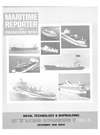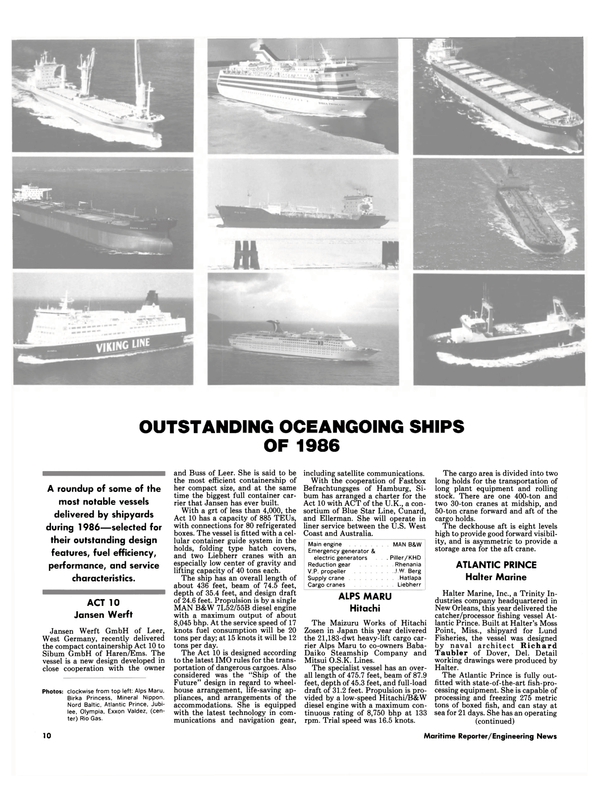
James J. Henry
James J. Henry, a leading naval architect and the founder and president of the naval architectural and marine engineering firm bearing his name, died at the age of 73 on November 2, 1986 following a heart attack.
Born at Ancon, Canal Zone, on 22 June 1913, Mr. Henry was graduated from the Webb Institute of Naval Architecture in 1935. Following his graduation, he served in the Technical Division of the Bureau of Marine Inspection and Navigation, whose function is now performed by the United States Coast Guard. In 1938, he joined the technical staff of the United States Maritime Commission, working under the supervision of James L.
Bates, Director of the Technical Division. From 1941 to 1945 he was employed by the Consolidated Steel Corporation at Wilmington, Calif., where he supervised the construc- tion of the attack transports Doyen and Feland, the first vessels of their type. He later became assistant to the production manager, and was involved in the construction of Cl-B cargo ships, BD-1 troop transports and other vessels.
In 1946 he launched his own consulting naval architectural business, incorporating the firm as J. J. Henry Co., Inc. in 1951. Throughout the following 40 years Mr. Henry was recognized as a leading innovator in the design, conversion and modernization of specialized cargo vessels.
He was a pioneer in the development of vessels for the carriage of liquefied natural gas at cryogenic temperatures and near atmospheric pressure; his design in the early 1960s for Bridgestone Maru, the first large fully refrigerated LPG carrier, led to the construction by others of a worldwide fleet of over a hundred of such ships; he was in the vanguard of those whose promoted the container ship; the range of his designs for the jumboization and conversion of war-built ships (notably the T2 tanker and the C4 transport) to other uses included ore carriers, container ships and chemical carriers in addition to conventional petroleum tankers.
Among Mr. Henry's outstanding designs for new vessels were the Seabee barge carriers for Lykes Bros. Steamship Company, the C4- S-ls and C5-S-75a cargo ships for American Mail Line, Ltd., and the revolutionary 33-knot SL-7 contain- er ships for Sea-Land Service, Inc.
But his talents were not exclusively devoted to seagoing vessels: he prepared the design of the floating mammal pavilion for the New England Aquarium at Boston, and of barges and other less glamorous ship types.
Mr. Henry joined The Society of Naval Architects and Marine Engineers in 1937 and was elected an Honorary Member in 1970 and a Fellow in 1974. He served as the Society's president in 1969 and 1970. At its annual meeting in 1967, the Society awarded Mr. Henry the prestigious Vice Admiral "Jerry" Land Medal for outstanding accomplishments in the marine field. In 1977 he received the Society's David W. Taylor Medal for notable achievement in naval architecture and marine engineering. He was also the recipient of the "Elmer A. Sperry Award" for advancing the art of transportation through the development of barge-carrying ships, and was the author of two major papers before the Society: "Modern Ore Carriers" in 1955, and "Container Ships" (co-authored with Henry J.
Karsch) in 1966. For the latter, he and Mr. Karsch were awarded the Captain Joseph H. Linnard Prize for the best paper contributed to the Society during that year.
He served as chairman of the board of trustees of the Webb Institute of Naval Architecture and was a past president of the Webb Alumni Association and of the Whitehall Club in New York. He was a member of the board of managers of the American Bureau of Shipping, of the American Society of Naval Engineers, as well as many other maritime associations. He was also a member of the academic advisory board of the United States, Coast Guard Academy, and of the board of trustees of the United States Naval Academy Foundation, Inc.
Under the direction of Mr. Henry, J. J. Henry Co. became one of the world's largest and most highly respected naval architectural firms.
Ships bearing the hallmark of a Henry design were built or converted at shipyards in the United States and throughout the world. A friendly, congenial man whose enthusiastic support of the American marine industry and of Webb Institute was quickly perceived by those fortunate enough to cross his path, either in business or socially, Mr.
Henry devoted his career to his profession in a way that few persons will ever achieve. The maritime world will miss him and the insightful perspectives of naval architecture and marine engineering that were so much a part of his life.
Read James J. Henry in Pdf, Flash or Html5 edition of December 1986 Maritime Reporter
Other stories from December 1986 issue
Content
- $40-Million Containership To Be Built By Samsung page: 4
- Frederikshavn Werft Offers Color 20-Page RO/RO Ship Brochure page: 5
- Daniel A. Marangiello Joins ANADAC, Inc. page: 5
- New Offshore Committee Formed By SNAME— McClure Named Chairman page: 6
- Cost-Saving Numeric Control Service Offered By Maritime Design page: 6
- APL To Build Five New Ships page: 7
- Todd Signs Agreement With Australian Shipbuilder For Technology Transfer page: 7
- Volvo Penta Constructing New Production Facility page: 8
- Isle Of Man Ship Registry Growing page: 8
- James J. Henry page: 8
- OUTSTANDING OCEANGOING SHIPS OF 1986 page: 10
- THEODORE ROOSEVELT (CVN-71) COMMISSIONED page: 31
- Moss Point Marine Awarded $40.7-Million Navy Contract To Build Four LSVs page: 32
- N e w Book Accounts Histories of 500 Ships Built By Newport News page: 33
- Safety Coating Developed For Navy Is Commercially A v a i l a b l e For Marine Use page: 33
- U.S. NAVY SHIP PROCUREMENT THE FY 87 NAVY SHIPBUILDING AND CONVERSION BUDGET page: 34
- Major Navy Contracts page: 37
- $240-Million Modernization Program Announced For Portsmouth Navy Shipyard page: 38
- Sparrows Point Eligible For All Navy Contracts page: 38
- NCEL Develops New Multi-Function Tool For Naval Diver Use page: 38
- $1-Million Navy Contract To Airflow Company For Dockside A / C Units page: 38
- New Jam-Proof High-Speed Data Link Sought By Navy page: 38
- First Honeywell Hydrostar Plus System Sold To Navy page: 39
- Marine Machinery Association Discusses Quality Control With Navy Officials page: 42
- Hospital Ship USNS Mercy Dedicated At NASSCO In San Diego page: 42
- Tacoma Boatbuilding Launches Tenth T-AGOS For Navy page: 45
- Aegis Missile Cruiser xLeyte Gulf' Christened At Ingalls Shipbuilding page: 46
- Over Half Of Navy's Procurement Dollars Awarded Competitively page: 46
- Westinghouse Incorporates Proven GPC-1500 Controller Into C 0 / 0 2 Trim Package page: 47
- New Brochure Emphasizes Products & Services For Defense/Marine Industry page: 50
- GE's LM2500 Engines To Power Portuguese Frigates page: 50
- Falk To Market Masson Marine Drives page: 53
- NAVIGATION & COMMUNICATIONS EQUIPMENT page: 54
- New Corrosion-Resistant Monel Hose From Cajon page: 62
- Cunard Line To Spend $130 Million To Overhaul The Queen Elizabeth 2 page: 63
- Lubriquip Offers Literature On Automatic Centralized Lubrication Systems page: 63
- Koch-Ellis Provides Service To Meet Pollution Prevention Standards Of MARPOL 73/78 page: 63
- Mobil Oil Introduces Six Hydraulic Fluids page: 64
- Textron Marine Appoints L.N. Hairston Executive Director Of Marketing page: 64
- New Ship Repair Facility At Port Of Portland page: 65
- 300-Page Fishing Vessel Safety Manual Published page: 65
- TDI Catalog Now Includes 100-MM Chart Recorders page: 65
- Rockment To Supply Rockwool TNF Panel System For Cruise Liner page: 65
- General Electric Expands LM Family Of Aeroderivative Gas Turbines For Marine Service page: 66
- Magnavox Offers Dual Telephones With Satcom Terminals page: 69
- Bostik Introduces New Marine Grade Anti-Seize Compound page: 73
- Multipurpose Cargo Ship Launched At Jansen Werft Yard page: 73
- MacGregor-Navire System Centerpiece At Dartford 'Miniport' page: 74
- New Jamesbury Spring Actuator Is Compact, Corrosion-Resistant, Economical page: 74
- National Crane Offers Free Literature On Cranes For Marine Applications page: 79
- Farrell Says New Waterways Bill Is 'Major Step Forward' Toward Rebuilding Nation's Infrastructure page: 79
- St. Augustine Trawlers Delivers DeJong & Lebet-Designed Excursion/Diving/Cruise Ship page: 79


